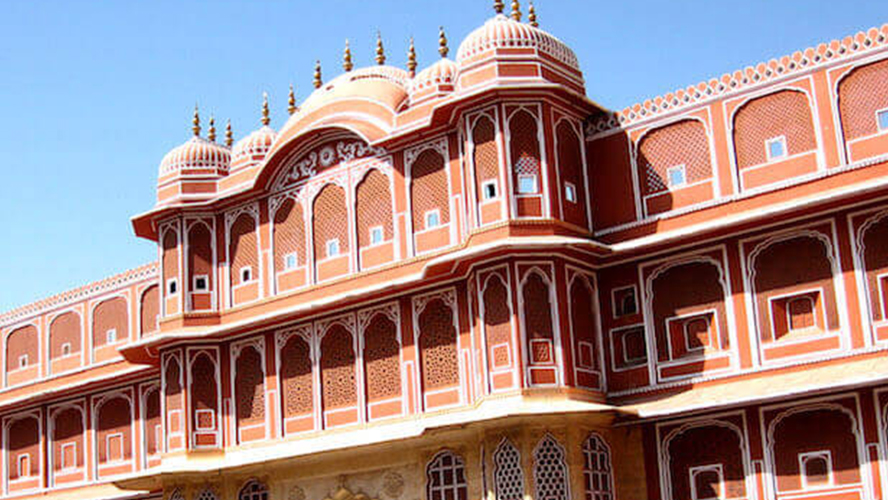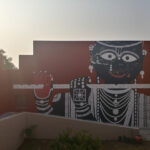The view of the city from the top of Nahargarh Fort was good enough to keep to motivated for the next day. It was a breathtaking aerial view of the city and it is very rare to get such a view of any city. I started from where I ended yesterday – Hawa Mahal.
My Jaipur Travelogue Part Two
You can read part one of my Jaipur travelogue over here. Once done, we can continue with this part two.
Hawa Mahal
The first surprise to me was to know that the trademark facade of Hawa Mahal – that has been pictured the most- is in fact not the front side of the palace. It is the back of the palace and this facade full of windows was created for the royal ladies to observe social gatherings and processions from the windows without being seen by the crowd.
Also read: Pushkar Camel Fair
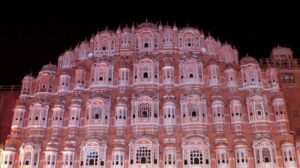
It is, in fact, a five storied building of rectangular plan spread around two courtyards. Truly I had no idea about the size of Hawa Mahal – before this day, I always thought Hawa Mahal is just that facade but it is not so.
Also read: Apple Service Centers in Jaipur
The five stories of the palace are named like this – Ground Floor: Sharad Mandir (here the autumn festivals took place); First Floor: Ratan Mandir (because of dazzling glassworks on its walls); Second Floor: Vichitra mandir (here the king worshipped Lord Krishna); Third Floor: Prakash Mandir (with open terraces on both sides) & the Top Floor: Hawa Mandir (because of its openness). The name of the palace has been derived from the name of the top floor.
Must read: Tourists Places in Jaipur
The ground floor has large open courtyards meant for the royal ladies to play Holi and celebrate other festivals. The first floor, where colourfull glasses are fixed on the walls, creates a dreamy environment.
The Vichitra Mandir floor is mostly undecorated and does not have anything is special. This floor was used by the king and was kept a secret for most of the time. It is still kept a secret. The top two floors are the best because these two are more open and allow a lot of light and wind.
The famous facade of Hawa Mahal can be accessed through a continuous verandah which ran just behind the windows and has a connection from each of the floors. Let me now come to the architecture of the facade.
Also read: 5 Star Hotels in Jaipur
The facade, though most of the building is painted in yellow, was built with red & pink sandstone and the shape of the pyramidal building was derived from the Crown of Lord Krishna.
It is a giant wall 15 meters high & full of Jharokha windows. There are 953 windows all designed with beautiful latticework. Becuase of this the wind when passes the window gets cooler and faster making a constant breeze flowing through them.
Also read: Govind Devji Temple Timing
Each window is also decorated with typical Rajasthani chhatris with metal finial. The use of white colour on the red sandstone makes the building even more beautiful.
Some Important Information about Hawa Mahal:
Timings: 9:00 a.m. to 4:30 p.m. (Closed on Friday)
- Entry Fees for Indians: Adult: 50 Rs.
- Children: 5 Rs.
- Entry Fees Foreign Nationals: Adult: 200 Rs.
- Children: 25 Rs.
Jantar Mantar
Hawa Mahal, situated at the heart of the pink city enclosure was a real surprise for me and from there I started walking towards the city palace complex – the royal residence. Jaipur city palace has been shown in many Bollywood films and the one I can clearly remember was ‘Bhulbhulaiya’.
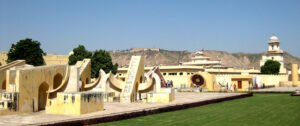
I was more enthusiastic about Jantar Mantar in Jaipur. Being in Delhi I was accustomed to the Jantar Mantar there but when I got the first glimpse of it from the top of Nahargarh – it looked much bigger. It is, in fact, the biggest Observatory in India while the ones at Delhi, Ujjain, Mathura & Varanasi are a smaller replica of it.
Also read: How to Be Safe in Jaipur
When Sawai Jai Singh, the founder of Jaipur felt that the Islamic calculation does not position the sun, moon and other celestial objects perfectly, he decided to create his own observatory and built this compound with 19 astronomical measurement instruments.
All my life I have seen small sundials but this was remarkable – human size sundial and other instruments to measure the position of celestial objects, calculate date & time and predict an eclipse. It was an amazing experience to see the shadows move in front of naked eyes.
Also read: Masala Chowk Jaipur
This happens with us all the time but never really notice it happening but there I saw a few children actually following the shadow of the sun which moves at a rate of 1mm/sec. The Jantar Mantar is a must watch place to understand astronomy better and also to understand the legacy of astronomy in India.
Some Important Information about Jantar Mantar:
Timings: 9:30 a.m. to 4:30 p.m (Closed on Friday)
- Entry Fees for Indians: General: 50 Rs.
- Students: 15 Rs.
- Entry Fees Foreign Nationals: Adult: 200 Rs.
- Children: 100 Rs.
City Palace
Across the road is the royal residence – the Jaipur City Palace. It was already noon, so, I decided to have lunch before entering the palace. A major part of the palace is used by the royal family till date and only a small part at the ground floor are open for tourists.
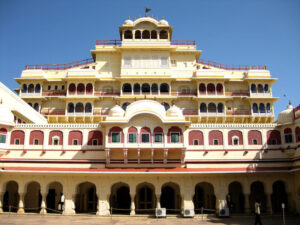
Entering the main entrance the first building that appears is the Mubarak Mahal. A beautiful two storied structure with fascinating artwork on it. Lovely pointed arched gateways in the ground floor and similar looking projected verandah in the first makes the building an outstanding example of Mughal-Rajput architecture.
Also read: Kite Festival Jaipur
This building was built as a waiting area for the special guests of the king. The next courtyard was approached through a beautiful arched gateway – Rajendra Pol.
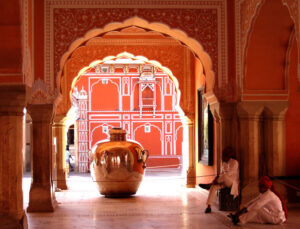
The gateway – with a large pointed arch gate in the middle and triple-arched verandah on two sides at two levels look amazing. The two elephants who stand on both sides of the gate were carved out of single pieces of marble.
The building that sits at the centre of this courtyard is the Diwan-i-Khas. A meeting place of the king with his special guests. The traditional red coloured building is a square hall with continuous arched portals on all sides but the most important element of it is the huge silver urns.
Also read: Gaitore ki Chhatria Jaipur

The Urns which is part of the Guinness World Record as the biggest urns in the world were used to carry Gangajal when Sawai Madho Singh travelled to England 1901. On two opposite sides of the Diwan-i-Khas courtyard are two gateways.
The first one – the Ridhi-Sidhi Pol leads to Pritam Chawk – a place where the royals used to celebrate festivals. On two sides of the Pritam Chawk are the four great gates of the Jaipur City Palace – The Rose Gate, The Green Gate, The Lotus Gate and the most famous the Peacock Gate.
The Gates represent each of the four seasons and four different gods of Hindu Mythology. On one side of the Pritam Chawk courtyard stands the seven-storied imperial residence – Chandra Mahal.
The palace remains closed to the public, though, a small part at the ground floor of it has been used as a museum displaying paintings, pictures and artefacts. On the other side of the courtyard is the royal arsenal.
On a separate courtyard lies the Diwan-i-aam, the place for the king to meet general people and a place to display royal chariots. The collection of the vintage chariots is remarkable.
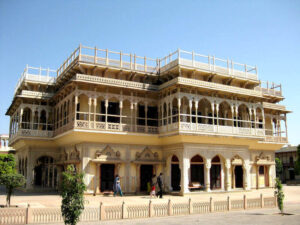
The Royal seat on which the king used to seat while meeting audience is also on display. The City Palace Jaipur is an extraordinary showpiece of traditional building styles of North India where courtyards played an important role.
The impressive architectural styles of the buildings, though does not go in total harmony, are a perfect blend of Mughal & Rajput architecture.
Some Important Information about City Palace Jaipur:
Timing: 9.30 a.m to 5p.m
- Entry Fees for Indians: Adults: 100 Rs
- Children (5 -12 yrs): 50 Rs
- Videography: 300
- Entry Fees for Foreign Nationals: Adults: 400 Rs
- Children (5 -12 yrs): 250 Rs
- Videography: 300
Chhatris of Gaitor
It was still some time for the sunset; So, I started for the Chhatris of Gaitor. The place is at some distance from the city but en route my driver stopped at a place for me to see the Jalmahal Palace.
The Palace which looks like a giant ship floating on the lake is another architectural marvel. The five-storied palace is not open to tourists and can only be seen from the banks of the Mansagar Lake.
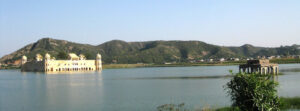
When the lake is full, four out of the five stories of the building gets submerged. The Top is beautifully decorated with traditional Rajasthani Chhatris. The central one is rectangular and the corners ones – octagonal. The top terrace of the palace has been used as a roof garden which looks amazing.
On my way, I was doing to short recap in my mind of what happened that day. It is true; Jaipur has a lovely sense of pink. The royalness of the pink used on the walls of the city makes it amazingly vibrant.
In fact, it is same as most Indian cities. The streets are full of men, animals and vehicles. The unorganised feeling which is a trademark in all Indian cities is there in Jaipur also but just because of the uniform royalness in its urban fabric, it looks so different. Jaipur is surely a fascinating example of urban planning and there are so much to learn from it.
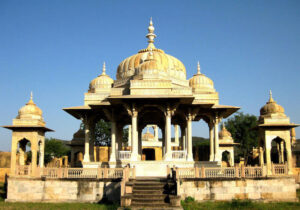
The Gaitor chhatris are basically a cenotaph of the royal family and beautifully decorated chhatris are built for each of the kings. The most prominent one surely belongs to the great king Sawai Jai Singh II.
The place is beautiful and serene and the buildings mostly crafted in Marble are all extremely fascinating. The name Gaitor has come from ‘Gaye Ka Thor’ which means resting place for the departed souls. Gaitor cenotaph does not have entry ticket and remains open till sunset.
With that, my time to depart was close. I wanted to visit Galta Temple and Albert Hall Museum but there was no time. I will surely give a visit to these places on my next journey to the City.
About The Author:
Sidhu Jetha (The Nomadic Architect) is a Kolkata based travel blogger who has set a life goal of visiting all historic places of India to get the essence of Art & Architecture of the glorious past of the country. To read more about him follow the below links;
- His Blog: www.thenomadicarchitect.com
- Facebook: https://www.facebook.com/The-Nomadic-Architect-2255213787852876/
- Twitter: https://twitter.com/dnomadarchitect
- Instagram: https://www.instagram.com/dnomadicarchitect/
- Pinterest: https://in.pinterest.com/dnomadicarchitect/
Note – This post was submitted by one of our readers, checked and published by JaipurLove editorial team. If you have been to Pink City and looking to get your experience published on this platform, kindly contact us with a request for the same.

